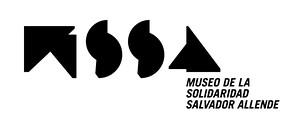September 1, 2018–February 3, 2019
Región Metropolitana
Av. República 475
8370269 Santiago
Chile
Hours: Tuesday–Sunday 10am–6pm
T +56 2 2689 8761
museo@mssa.cl
Reclaiming art in community
A historic neighborhood in downtown Santiago co-creates an exhibition experimentally. A dismembered art collection making progress towards its restitution. Indigenous communities, local agents and science professionals helping an artist to create her proposal in the desert. These are the stories that underlie the current three exhibitions at MSSA, which recall the foundational impulse of this museum, collaboratively created in 1971, working today at the crossroads of “art, politics and community.”
Considered one of the most relevant collections of modern and contemporary art in Latin America, the Museo de la Solidaridad [Museum of Solidarity] was built following an unprecedented model of collaboration and donation by international artists committed to the proposal of a “museum for the Chilean people.” This idea was fostered, amidst social reforms, by former President Salvador Allende, together with Brazilian art critic Mário Pedrosa, with the support of outstanding intellectuals such as US art critic Dore Ashton, French art historian, Jean Leymarie, and Spanish critic, José María Moreno Galván.
46 years after this unique and utopian deed, and when the effects of the dictatorship (1973 - 1990) are still felt in Chilean society, the questions about the meaning of solidarity haunt MSSA. Who is today the “Chilean people”? How can we generate a closer communication? How can we contribute to the recomposition of social fabric through art? The current three exhibitions attempt artistic proposals to recover social bonds, based on the role of the local, national, regional and international community.
Co-creation and neighborhood
The exhibition Haciendo barrio (Making neighborhood) is the result of an outreach work with the territory that, over two years, the MSSA has promoted in the República Neighborhood, a sector in Santiago where the museum is located.
The exhibited works are the result of a participatory curatorship that reclaims the experiences and stories of the residents of this neighborhood in the center of the city, unexplored so far. These works embody the intensities of the neighborhood in its denomination as “heritage site” for its historical and architectonic richness, while they symbolically confront the housing development boom, crime rate and the growing diversity of its inhabitants.
Textiles, videos, writings, publications and photographs are part of the experimental works created collaboratively by neighbors, artists and museum professionals, through a series of reflection meetings and workshops, sponsored by the participatory research project Mirada de Barrio (Neighborhood gaze), the goal of which was to activate the senses of community, neighborhood networks and appreciation of the neighborhood through art.
A collection that recomposes itself
Debut. 43 obras se reencuentran con su colección (Debut. 43 works reunite with their collection) is an exhibition that celebrates the arrival at the museum collection of a series of works donated between 1972 and 1973, which remained hidden in the storage facilities of another museum during the Chilean dictatorship (1973-1989). Over decades, the MSSA carried out several attempts in order to rescue and exhibit these works, which was finally made possible thanks to a joint work involving the National Museum of Fine Arts (MNBA) and the National Center for Conservation and Restoration (CNCR).
For the first time, reunited with their collection, we find the exhibition of works by Rodolfo Abularach, Graciela Aranís, Arnold Belkin, Ueli Berger, Marino Biarge, Rafael Bogarín, Marcelo Bonevardi, Serge Brignoni, Jacques De Feline, Paul Delapoterie, Jorge Luis Ducet, Gerald Ducimetiére [John Aldus], Marianne Eigenheer, Fedor Ganz, Rémi Gay, Vita Giorgi, Leonel Góngora, Nancy Graves, Arnold Gross, Albert Lasseur, Laura Márquez, Roberto Matta, Luis Molinari-Flores, Robert Motherwell, Tetsuya Noda, Miguel Ocampo, María Luisa Pacheco, César Paternosto, Liliana Porter, Omar Rayo, Luis Alberto Solari and Jack Youngerman.
Community and critique
Hidroscopia Loa (Hidroscopy / Loa) is an installation by media artist Claudia González that brings together sound art, prints based on water particles, and videos. Her work observes, from the perspective of the territory, the crisis of the Loa river, the longest river in Chile, as well as the most polluted one.
The artist developed a research methodology, where the participation of communities directly affected by the Loa’s problems was relevant, as well as that of a group of experts in environmental issues. They provided key indications for the development of her critical exploration related to the convergence of water, electricity and copper.
International connection
Currently, the MSSA is carrying out research together with an international artistic community in order to continue collecting information about the history of the museum and its links to countries such as Mexico, Spain, Cuba, Holland and Slovenia, which become papers, books and international exhibitions. At present, a fundamental work by artist Myra Landau, belonging to the MSSA collection, is exhibited in Art without Guardianship: the Salón Independiente in Mexico at the Museo Universitario Arte Contemporáneo, MUAC, Mexico. Along the same lines, the museum is participating, through research and activation of its historical archive, under the name No containment. MSSA, the museum as spore in the context of the exhibition Southern Constellations. Poetics of the Non Aligned, which will be inaugurated in 2019 at the Moderna Galerija in Ljubljana, Slovenia, curated by Bojana Piškur.
Going beyond the boundaries of the museum and its context, to create and reconstruct links with professionals and institutions promoting this task, remains the basis of the MSSA’s work, a space that, like few institutions, exists thanks to the solidarity gestures of different communities in diverse moments and places in history.


